We treat garlic diseases ourselves and get rid of pests: effective methods and preventive measures
Since childhood, everyone knows that garlic is an excellent means of preventing various diseases. All of him beneficial features you can't count it right away. However, garlic itself, like other plants, can infect pests and various diseases.
In this article, we will take a closer look at the diseases of garlic, as well as how to deal with them and methods of prevention.
The content of the article
Diseases of garlic: treatment and prevention
Basically, garlic affects fungal diseases. There are also viral (yellow dwarfism) and bacterial (bacteriosis) diseases.
The pests most often attacking garlic include the garlic mite and stem nematode.
Pink root rot
Pink rot is a fungal disease (caused by the fungus Phoma terrestris), which is transmitted mainly through soil or infected planting material.
The optimum temperature for the development of the disease is from +25 to +30 degrees.
- Signs. Pink rot attacks the root and outer scales, almost never killing the plant. At first, the roots turn light pink, then red and purple. In the end, they finally darken and die off.
- Treatment. Fungicides can fight pink root rot. For example, "Quadris".
- Prevention. Be sure to follow the rules of crop rotation: you cannot plant garlic for 4 years in the place where bulbous ones grew. Before planting, it is recommended to treat the planting material with disinfectants.
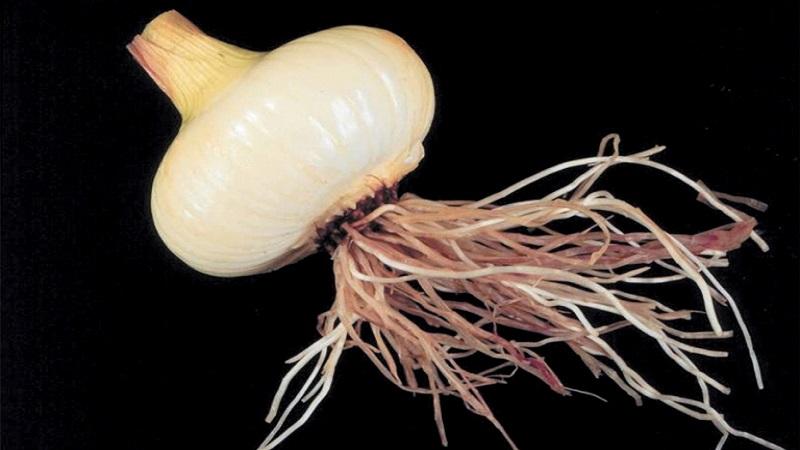
White rot
The white rot of the bottom is sclerotinia. The causative agent is the fungus Sclerotium cepivorum. Infection occurs through the soil at temperatures from +10 to +24 degrees. White rot is one of the most dangerous diseases for bulbs.
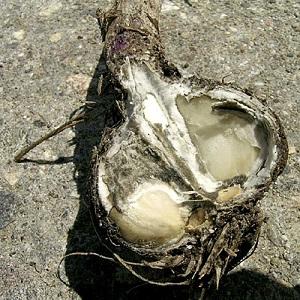 Signs. White rot destroys the root of the plant, then the bulb decays gradually. The fungus appears in the form of a white mycelium on the root and bulb. External signs of the disease include yellowing of the leaves, starting at the tips.
Signs. White rot destroys the root of the plant, then the bulb decays gradually. The fungus appears in the form of a white mycelium on the root and bulb. External signs of the disease include yellowing of the leaves, starting at the tips.
Treatment. At the first signs of the disease, fungicides will help: "Custody", "Switch", "Uniform".
Prevention. For the preparation of planting material, the preparation "Maxim XL" is used, which helps to protect the plant, including from white rot. To prevent white rot, use only clean and healthy planting material, clean tools and containers. Don't forget about correct crop rotation.
The causative agent of white rot of garlic (spores) remains dry for several years. It can be found on boxes, tools and other surfaces in contact with a diseased plant. Therefore, it is necessary to disinfect all inventory.
Fusarium
Fusarium rot of the bottom of garlic is caused by fungi of the genus Fusarium. Fusarium infection occurs through the bulb, soil and plant debris.
The disease spreads best in heat (28-32 degrees) and high humidity.
- Signs. The leaves begin to turn yellow and brown at the tips, gradually moving downward. A pink bloom can be seen on the false stem. The root and bulb turn pink and rot. White fungus spreads inside the bulb.
- Treatment. The means of struggle at the first signs of fusarium are the same as with white rot: "Custody", "Switch", "Uniform".
- Prevention. Use fungicides as disinfectants - for example, the preparation "Maxim XL". Remove infected plants along with a clod of earth and burn them.Disinfect tools, observe crop rotation.
Important! The fungus that causes fusarium produces toxins. It can cause severe poisoning.
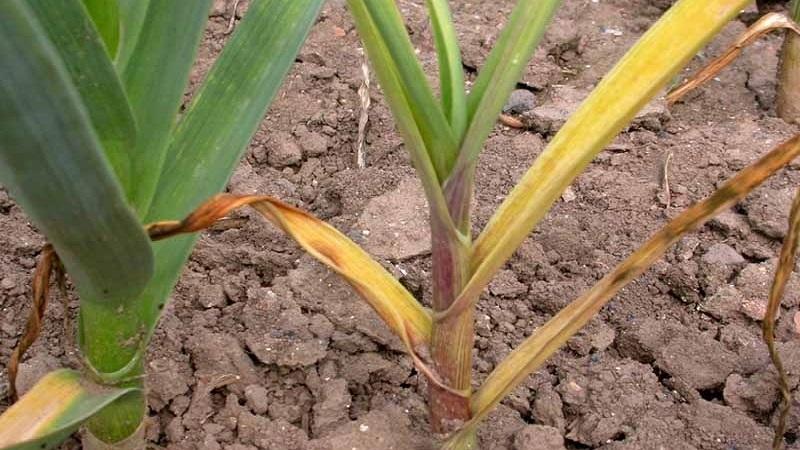
Cervical rot
Cervical rot is caused by a fungus of the genus Botrytis. Basically, the disease affects garlic during storage. Infection occurs through soil or diseased planting material. The ideal temperature for the development of the disease is from 15 to 20 degrees.
Signs. The disease manifests itself 1-2 months after harvest. The neck of the bulb begins to rot: the latter becomes soft and slimy, a gray fluffy bloom appears on it.
A gray-brown bloom stains the cloves of garlic. Over time, the disease spreads throughout the bulb. In 1-2 months, the neck rot completely affects the bulb (it rots) and infects healthy garlic.
Treatment. Since the disease does not manifest itself in any way during the growth of the plant, it is almost impossible to take timely measures to combat it. But fungicides effectively fight against cervical rot during the growing season of garlic. For example, already mentioned above "Custody", "Switch", "Uniform", as well as "Ridomil Gold" and "Acrobat".
Prevention. Etching with the preparation "Maxim XL", observance of crop rotation, order of fertilization, obligatory use of phosphorus fertilizers. It is important to harvest the crop on time and dry the bulbs before storing them until the leaves dry.
Don't be too lazy to sort your garlic to keep only healthy bulbs. Storage conditions: temperature from 0 to -2 degrees, humidity - not higher than 70%.
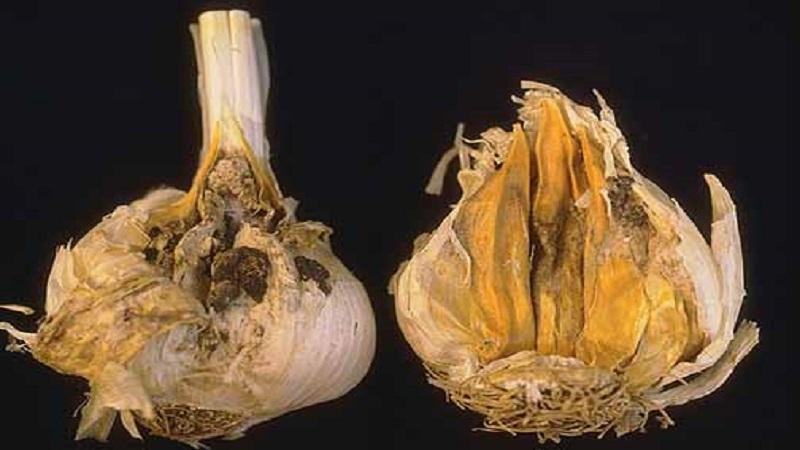
Penicillosis
Garlic penicillosis is also called blue, blue or green mold. The causative agents are fungi of the genus Penicillium. Most often, the disease spreads through the use of contaminated planting material.
During storage, the spores move from the diseased bulb to the healthy bulb. The result is clearly visible in the photo.
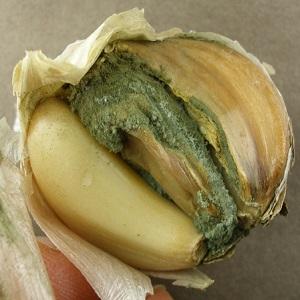 The disease develops at high temperature and humidity in storage.
The disease develops at high temperature and humidity in storage.
- Signs. Outside, penicillosis can be seen by yellowing leaves, short stature and a blue-green bloom at the base of the plant. The bulb is covered with a white bloom, which later turns green. The bulb falls apart into cloves, sluggish to the touch.
- Treatment. Use fungicides at the first sign of illness. For example, "Quadris", "Shirlan" or "Bumper Super".
- Prevention. Carefully select the planting material - plant only healthy, pre-treated with antifungal drugs. Make sure to rotate correctly, destroy infected bulbs, do not compost.
The harvested garlic must be dried for 3-4 weeks before storage. Store garlic at a temperature not exceeding 10 degrees and a humidity not exceeding 60%.
Aspergillosis
Aspergillosis is also called black mold or garlic soot. The disease is caused by fungi of the genus Aspergillus. The disease is transmitted through soil (plant debris), air (spores are carried by the wind) and contaminated planting material. It develops in conditions of high temperature and humidity.
Signs. Black dusty mildew around the neck, which further spreads throughout the bulb.
Treatment. To combat black mold during the growth of garlic, the same fungicides can be used as for penicillosis: Quadris, Shirlan or Bumper Super.
Prevention. Treatment of planting material with antifungal dressing agents, storage of garlic and planting material at low temperatures (+1 - +12 degrees, humidity not more than 65%). Drying the garlic after harvest before storing.
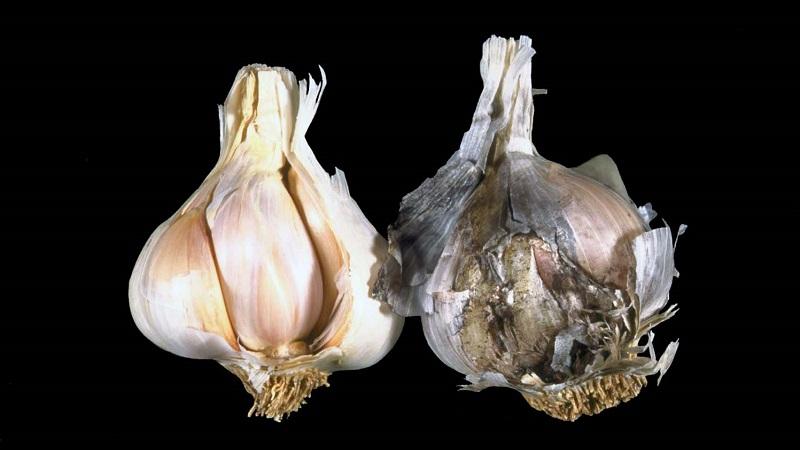
Peronosporosis
Peronosporosis, or downy mildew, destroys most of the garlic crop. The causative agent is Peronospora destructor Casp. It develops in cool and humid weather.
Transmitted through soil (plant debris), contaminated planting material and garden tools.
- Signs. Yellow spots appear on the arrows of the garlic, which are later covered with gray or purple spores. The leaves first curl, then dry out.
- Treatment. It is recommended to use fungicides to combat downy mildew. For example, "Quadris", "Areva Gold" or "Ridomil Gold".
- Prevention. Using only healthy planting material, processing it before planting. Avoid the top glaze, or water the garlic in the morning so that the water on the leaves has time to dry until the evening.
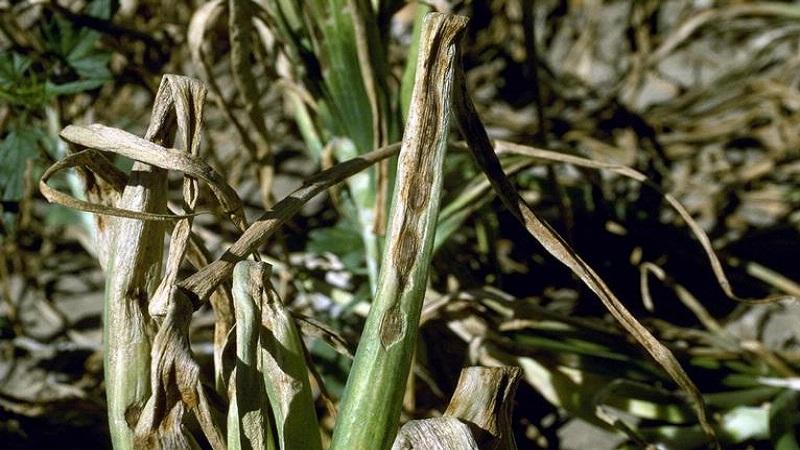
Rust
The mushroom Puccinia alli causes garlic rust. This disease does not kill the plant, but it slows down its growth. It develops in cool and humid weather.
Signs. Rusty dots or spots appear on the leaves, which later turn black.
Treatment. To combat the spread of rust, it is recommended to cut off the affected leaves immediately. Such fungicides as "Quadris", "Bayer", "Nativo" and "Syngenta" showed the best results in the fight against this disease.
Prevention. Crop rotation, access to sunlight. Avoid watering in the evening.
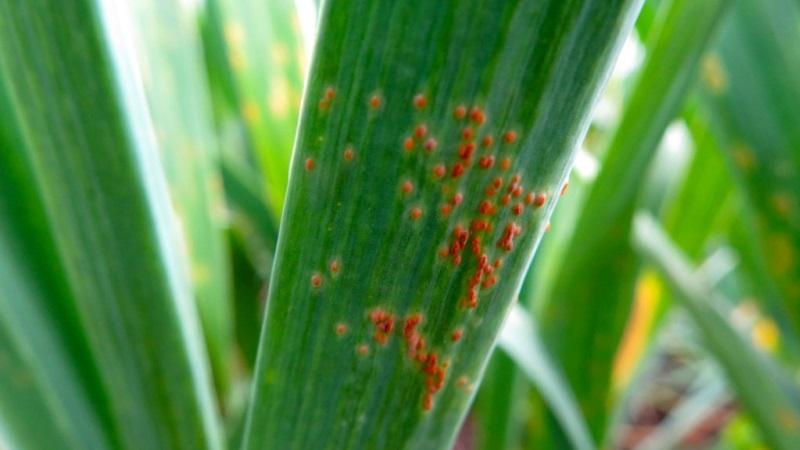
Yellow dwarfism
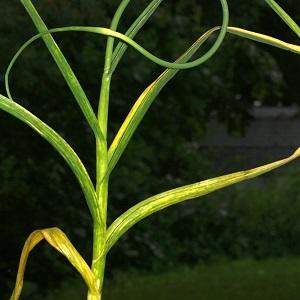 Yellow dwarfism is a viral disease of garlic. The virus is transmitted by pests (aphids, garlic mites, stem nematodes) and through infected planting material.
Yellow dwarfism is a viral disease of garlic. The virus is transmitted by pests (aphids, garlic mites, stem nematodes) and through infected planting material.
- Signs. The leaves are covered with yellow spots, bend at the base and lean towards the ground. Diseased plants are shorter than healthy ones.
- Treatment. There are no chemical ways to combat the yellow dwarfism of garlic, so follow prevention.
- Prevention. Use only healthy planting material, fight pests that carry the virus. Destroy infected plants, do not compost.
Bacteriosis
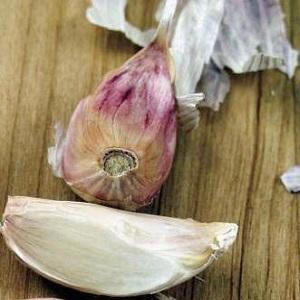 Garlic bacteriosis, or soft bacterial rot. The causative agents are Erwinia carotovora bacteria. It is spread by insects, rain and irrigation water. It develops in warm and humid weather.
Garlic bacteriosis, or soft bacterial rot. The causative agents are Erwinia carotovora bacteria. It is spread by insects, rain and irrigation water. It develops in warm and humid weather.
Signs. One or more teeth are softened and saturated with liquid. The cervix is soft when pressed, giving off a fetid fluid.
Treatment. Fungicides: "Pergado", "Kurzat R."
Prevention. Drying before storage, storage at low temperature and humidity no more than 65%. Avoid overhead watering, control pests, use copper-based bactericides.
Stem nematode
Nematoda is a microscopic worm that infects all parts of garlic except the roots. It feeds on plant sap and completely destroys it.
- Signs. Light streaks on leaves, curling and drying of feathers and bulbs. Unpleasant rotting smell.
- Treatment. To combat stem nematode, it is recommended to use nematicide insecticides, for example, "Akarin", "Fitoverm", "Nemabakt". They can be dissolved in water for irrigation or embedded in soil.
- Prevention. Compliance with a 4-5 year crop rotation. Processing of planting material with hot water: 10-15 minutes at 40 degrees, 5-6 minutes at 45 degrees or 2-4 minutes at 55 degrees. It is necessary to carefully select planting material, to disinfect garden tools.
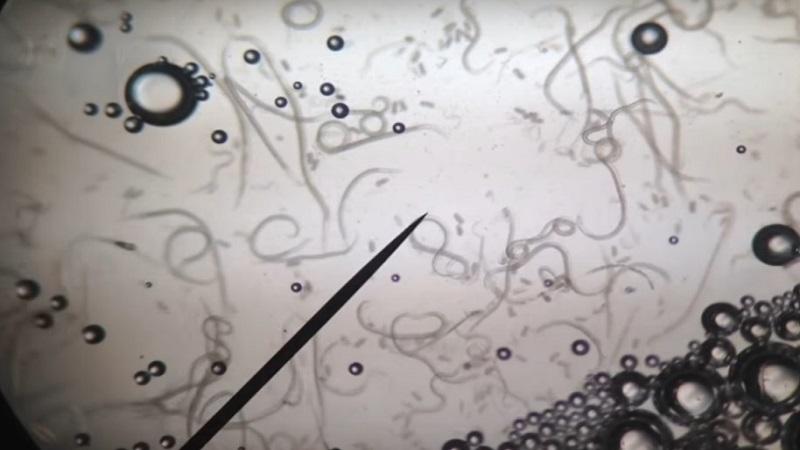
Garlic mite
The four-legged garlic mite infects garlic both during growth and storage. Infection occurs through land, wind and contaminated planting material.
Tick size - no more than 0.25 mm. The female lays eggs on the tissues of the plant, which overwinter on the heads of garlic after harvesting.
Signs. The appearance of light brown or yellow spots on the green parts of the plant and the cloves, the juices of which feed the tick and its larva. Poor development and curvature of leaves. The appearance of a white coating is possible.
Treatment. If ticks are found, the plant must be treated with acaricides or insectoacaricides ("Vertimek", "Bi-58 Novy").
Prevention. Deep plowing of the beds, compliance with crop rotation. The high acidity of the soil encourages the development of mites.Pre-planting treatment of cloves with acaricides or insectoacaricides.
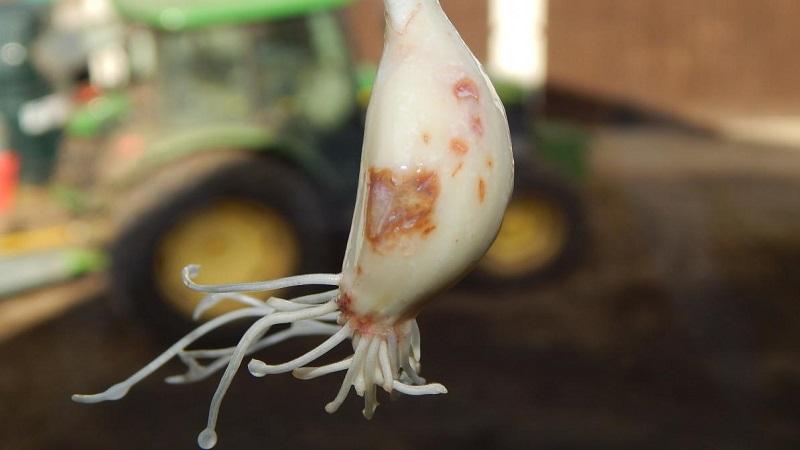
General recommendations for the prevention and protection of garlic
The main rules for the prevention of diseases of garlic and its damage by pests are compliance with a 4-5-year crop rotation and careful selection of only healthy planting material. Never compost infected plants - they must be burned.
Many diseases of garlic develop during storage. Therefore, it is necessary to follow the rules of harvesting and preparing the crop for storage, as well as the storage conditions for garlic.
For prophylaxis, it is also recommended to pre-treat the planting material - by drying, hot water or chemicals. Do not forget to disinfect garden tools, shoes and clothing that may have come into contact with infected plants.
At the first signs of disease or pest infestation, the only control methods are chemical preparations: fungicides, insecticides, acaricides, etc.
Important! Chemical preparations must be used very carefully: plants can only be treated with chemicals intended for them, aimed at combating a specific disease or a group of diseases. Follow the directions for use of these drugs carefully.
Conclusion
Garlic is a healthy crop that every gardener and gardener simply must grow. Simple preventive measures will help protect it from diseases and pests.
If the disease still affects the garlic, do not be discouraged. Almost any disease is amenable to therapy, the main thing is to notice its first signs in time.